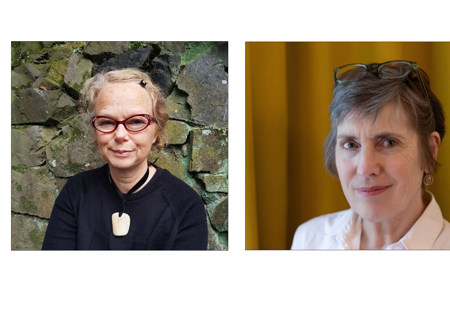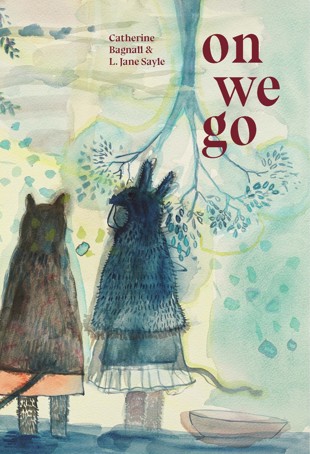Q1: Your beautiful book is at the printer. How does that feel?
CB: Absolutely thrilling — making a book when you love books is a thrill and working with Anna, Jo and Emily on the design, seeing it all come together, is so good.
JS: I feel surprised, charmed and a bit spangled.
Q2: It’s a remarkable collaboration between an artist and a poet. How did the idea develop?
CB & JS: Through friendship and a happy experience exploring Paradise Valley in the South Island together, back in 2009 The Paradise Valley Project was a writing and performance project, musing on a particular place and what inhabited that place (rodents, us, moss, beech trees). We’ve wanted to do another project for a while and realised that by using the work we were already doing, from opposite sides of the world we could put the paintings and poems together.
Q3: Can you describe the process by which you built it together?
CB: From a distance. Jane was living in Munich and I was in Wellington and we emailed each other all the time, sharing thoughts and descriptions of the things we saw on our wanderings, discussing the ecological crisis and other artists and writings whose work is a response or call to action, economics, what we were reading and wearing. The book idea came out of those conversations.
JS: When I came back to New Zealand in 2019 we got together with A4 printouts of our work, threw them all over the floor at Catherine’s house, cut them up, and made a booklet loosely based on the seasons. It took the insights of her husband to show the way to the final narrative sequence.
Q4: Were the poems written in response to the paintings, or the other way around?
CB: Neither, we have very different practices We experimented with ways of putting the works together and after quite a few goes it worked.
JS: The work was simply made for itself and the connections materialised later.
Q5: The book is unique. How do you think it is best categorised?
CB: I think the book might fit in a bookshop between fairytales, stories and books on ecological thinking.
JS: I agree, in fact, for this particular topic, why not banish the Dewey system altogether? It’s so annoying to have poetry on the other side of the shop from books on New Zealand birds, and histories at knee level somewhere far from the high table of economics, or countries separated.
I’d like On We Go to be found on a big ‘Nature Table’ at the front of a bookshop. It would be the first thing you bump into when you go in, and would group titles from all genres on the theme of ecological thinking. Would that be a nightmare for bookshop staff? I’d hope it would be liberating.
Q6: Did you have any exemplars in mind when you began to plan it?
JS: I love the tradition of words and images sharing a space, whether it’s birds, plants and names on a roman mosaic floor, a mediaeval book of hours going through the seasons, or Philip Larkin doodling little creatures in the margins of a letter to a friend. I’m happy to swim in that stream.
CB: I was shown examples of older New Zealand journals and small-print runs where writers poets and artists worked alongside each other but mostly I want to work with images and text but without the images illustrating the poems. Since we have put our book together I have been hunting for other examples of poets and artists working together and there are many wonderful examples.
Q7: A current of mindfulness runs deep throughout. How do you hope readers might experience the book?
CB: The word mindfulness I’m not sure about, but I like Rosi Braidotti’s idea of ‘a new love of the world’, or for me I guess it might be more an old love of the world.
JS: I hope to communicate something of the pleasure I feel when I attach a personal memory to a particular landscape and find the words to venerate it.
Q8: And how do you imagine they might they use it?
JS: It’s a lovely portable size so on their travels perhaps, or by their bed for those going to sleep and waking up moments.
CB: I don’t know if the book is useful, but I hope readers might disappear into it, then look out the window and see things differently. And maybe find joy in it.
Q9: What do you hope it will spark?
CB: Oh golly! I can’t answer that. The same feelings of wonderment that I got as a child reading the Moomintroll books, and still get when I read them now.
JS: On a good day, an awareness of being in and of the natural world, and of the depthless energy that is a continuing legacy from childhood.
Q10: Do you feel that the general public is hungry for books that tap into ecological thinking, as a means of seeing a way forward?
JS: I do. However the focus on ecological science and technological determinism today undervalues the practical, useful side of the mysterious human imaginary; of the arts. Poets are more or less addicted to the natural world anyway, so poetry has been hard at work on the theme forever.
CB: Yes, I do think that people are hungry for books that tap into ecological thinking; and there are a lot of these being published at the moment. I am enjoying reading post-human theory and ideas about different ontologies — and thinking about what that means and looks like. It makes me wonder how can I be with a tree? Or what happens if I dress up as a creaturely other? I have always been nervous about reading poetry, but I’m beginning to understand just how extraordinary it can be: opening up ways of thinking and feeling about being alive in a world so full of other real-life creatures and living things. And I guess my paintings are another response to that; I hope our readers will feel that too.


